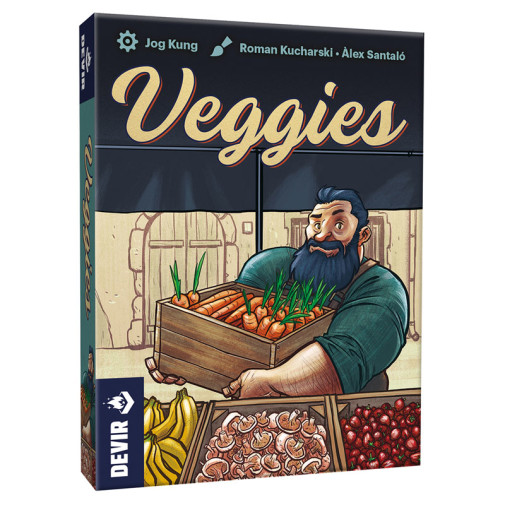We use cookies to make your experience better. To comply with the new e-Privacy directive, we need to ask for your consent to set the cookies. Learn more.
Veggies Game
Go to the central market and choose from grapes, strawberries, bananas, carrots, and mushrooms, to build your market stand. Besides produce, there are also empty pallets, crates and drums as well as mice. This is a colorful, quick and easy card game for 2-4 players, with elements of both luck and strategy in which players try to create the largest contiguous groups of different fruits and vegetables. Cards are placed in each player’s personal market by either drawing from their hands or from a face-up card in the central market. These cards can either be put adjacent to or overlapped in order to cover rats, which will lose points if viewable or to help enlarge a group of produce. When each player has placed eight cards, the game ends. Points are scored for the largest group of produce of each player’s choice, so a good strategy is to try to choose a different group than your neighbors are building. Final scores are tallied for a chosen produce group based on the number of distinct groups there are of that chosen group multiplied by the number of items in their largest group of that food. Empty pallets are worth 0 points, and mice are -2 points; because mice will scare away customers! The winner is the player with the most points. Playtime is approximately 20 minutes.
Veggies is a Jog Kung card laying game illustrated by Roman Kucharski and Àlex Santaló. The games last about 20 minutes and can be played by 2 to 4 players from 8 years old. To win, you have to score the most points by grouping sets of fruits and vegetables in your market stall, avoiding the mice.
A few minutes after opening the box, you will be playing! Shuffle the 40 cards and form a single deck, then reveal the first three cards and place them in view of all the players, forming the central market. Next, each player takes two cards from the deck, keeps one and plays the other in front of him, forming his own market stall.
All the cards have a similar structure. You will always find six spaces that can be occupied by three types of symbols: any of the five types of fruits and vegetables (strawberries, bananas, grapes, mushrooms and carrots), empty boxes and pallets, or mice. As you can imagine, you have to do everything possible to preserve the goods and avoid empty boxes and mice.
Taking turns, starting with whoever has worked most recently in a market, players will add a card to their own stall, either the one that was hidden in the hand or by taking one of those offered by the central market. If played from the hand, draw a new card from the central deck and keep it in the hand. If you opt for one from the market, draw a card from the deck and leave it in the center of the table, so that three cards are available again.
Now, how to play the cards in our market stall? You can rotate the card as you wish, to orient it and place it either vertically or horizontally. You can place it adjacent (completely or partially), orthogonally, to at least one of the cards already present in your stand. You can also cover, completely or partially, at least one of the cards already present in your stand. It is not allowed to place them underneath! This process will help you to gather goods of the same type, to get larger groups of fruits and vegetables, and at the same time to do without boxes and rodents.
When all players have 8 cards in their stall, the game ends and the scores are calculated. Each player determines which type of merchandise constitutes the largest group in his market stall, i.e. the set of spaces with the same type of merchandise and which are orthogonally adjacent to each other. If a player has several types of merchandise that could form his most numerous group, he must choose one of them. He then announces it to his opponents. All players then earn points for each type of merchandise they have that matches that of any player's largest group. Each player counts the number of spaces in his most numerous group of a given commodity to be scored and multiplies it by the number of separate groups of that type he has in his stall, including the most numerous. Repeat this calculation for each of the types of goods to be scored, add up all the points and finally subtract 2 points for each mouse you have in your market stall. The player with the most points is the winner!
Veggies is a game to enjoy both with family and friends. It has 2-player and 4-player variants that make it very versatile and a fun challenge for all kinds of players. Fill your market stall with fruits and vegetables and get the highest score!
| Product Format: | Other |
|---|---|
| Brand: | Devir Games |
| Grades: | 3-AD |
| EAN/UPC: | 8436589625693 |
| Length in Inches: | 5 |
| Width in Inches: | 3.8125 |
| Height in Inches: | 1 |
| Weight in Pounds: | 0.3 |

